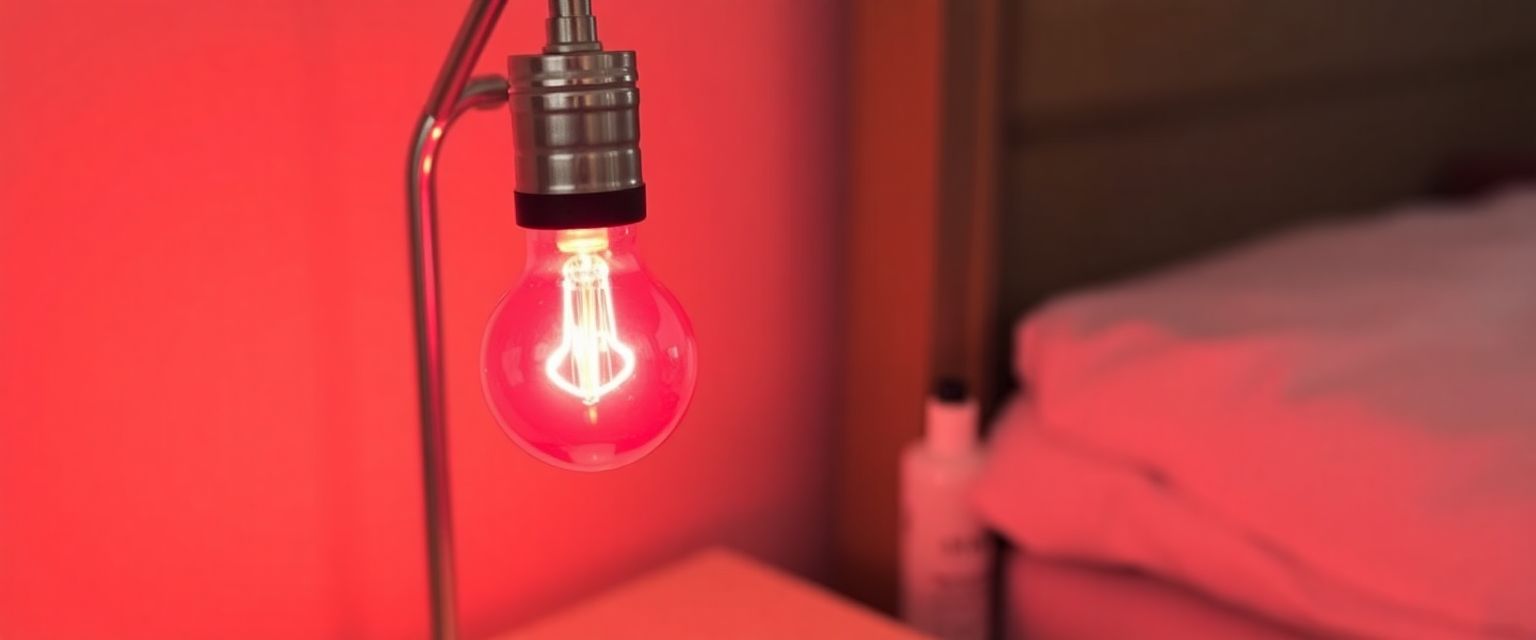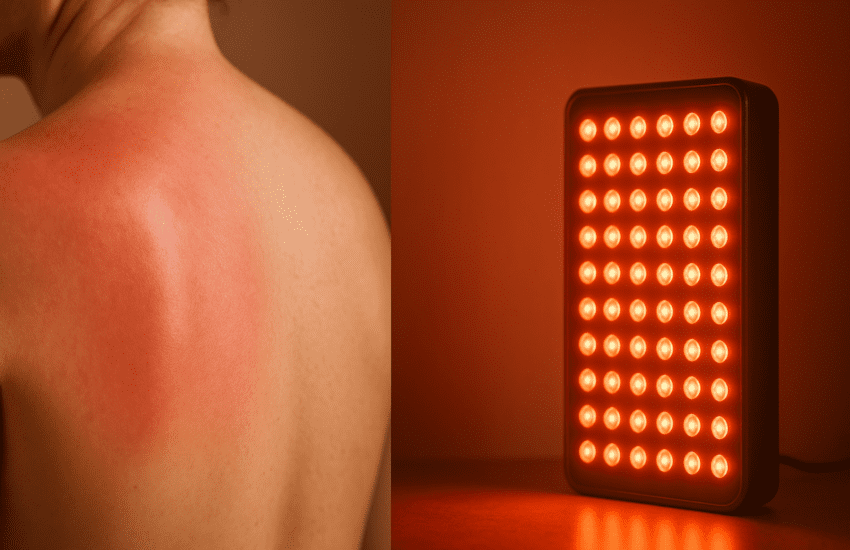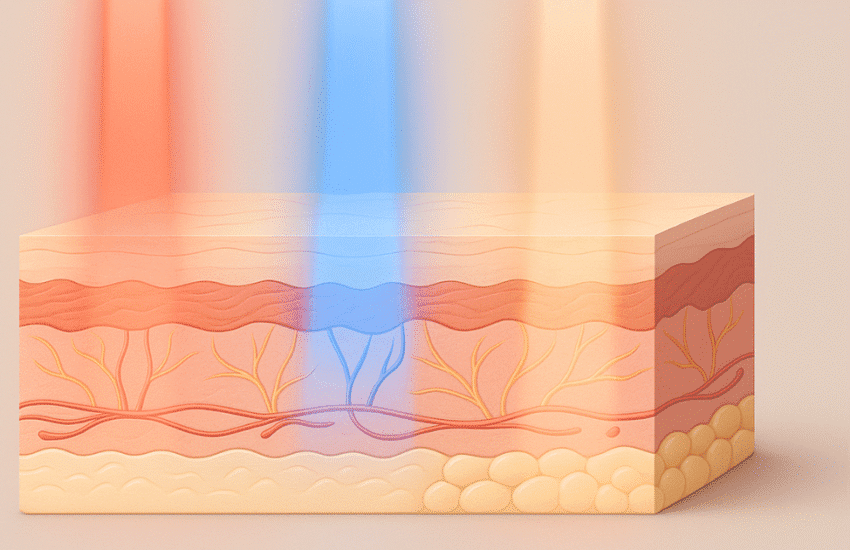Red Light Therapy Bulbs: What They Are, How They Work & What to Look For
Red light therapy bulbs have transformed home wellness routines, offering professional-level light treatment without the clinic visits. These specialized LED bulbs emit specific wavelengths (typically 630-660nm red and 810-850nm near-infrared) that penetrate skin at different depths to support cellular function.
Unlike standard lighting, these therapeutic bulbs deliver concentrated light energy that your body’s cells can use. Whether you’re targeting skin concerns, muscle recovery, or chronic pain, selecting the right red light therapy bulb can make all the difference in your results.
How Red Light Therapy Bulbs Work: The Science Behind Photobiomodulation
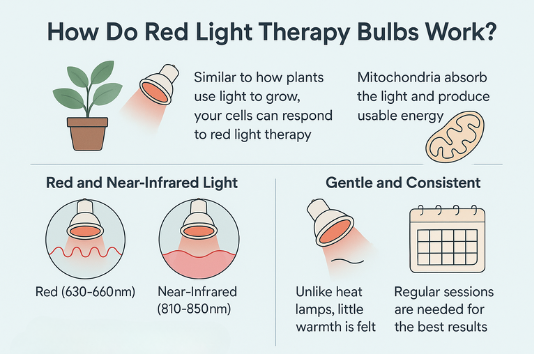
Plants use sunlight to grow, and your body responds in a similar way to certain types of light.
Red light therapy bulbs use specific wavelengths that interact with your skin through a process called photobiomodulation—thought to support cellular function and energy production.
Here’s the general idea: red light wavelengths (around 630–660nm) are believed to work at the skin’s surface, while near-infrared light (810–850nm) can reach deeper layers, including muscle and joint tissue. This light is absorbed by your mitochondria, the parts of your cells that help generate energy.
Unlike heat lamps or tanning beds, LED red light therapy produces little to no heat. At most, you might feel a mild warmth during use. The goal isn’t to heat the skin, but to deliver light at wavelengths the body can use.
It’s also worth noting that red light therapy typically requires consistent use over time. Think of it like watering a plant—one good soak won’t make it flourish, but consistent care will.
The Potential Benefits of Red Light Therapy Bulbs
While individual results can vary, a growing body of research and anecdotal evidence suggests that red light therapy may support a variety of health and wellness goals.
Below are some of the areas where it’s shown potential:
- Cognitive Function: Some research indicates potential benefits for brain health and cognitive performance.
- Skin Health: Red light therapy can help boost collagen production, potentially reducing wrinkles and improving skin texture.
- Pain Relief: Many users report reduced pain and inflammation, particularly in joints and muscles.
- Wound Healing: The therapy may speed up wound healing by promoting tissue repair.
- Hair Growth: Some studies suggest it could stimulate hair follicles and slow hair loss.
- Improved Sleep: Red light exposure may help regulate circadian rhythms, leading to better sleep.
- Mood Enhancement: There’s evidence that red light therapy could help reduce symptoms of depression and anxiety.
Of course, experiencing these potential benefits depends on using the right type of bulb for your needs. From wavelength to power output, there are a few key factors to consider before buying.
Need help choosing? Check out our guide best red light therapy bulbs for home use to compare top-rated options that balance power, wavelength, and ease of use.
How to Choose the Right Red Light Therapy Bulb
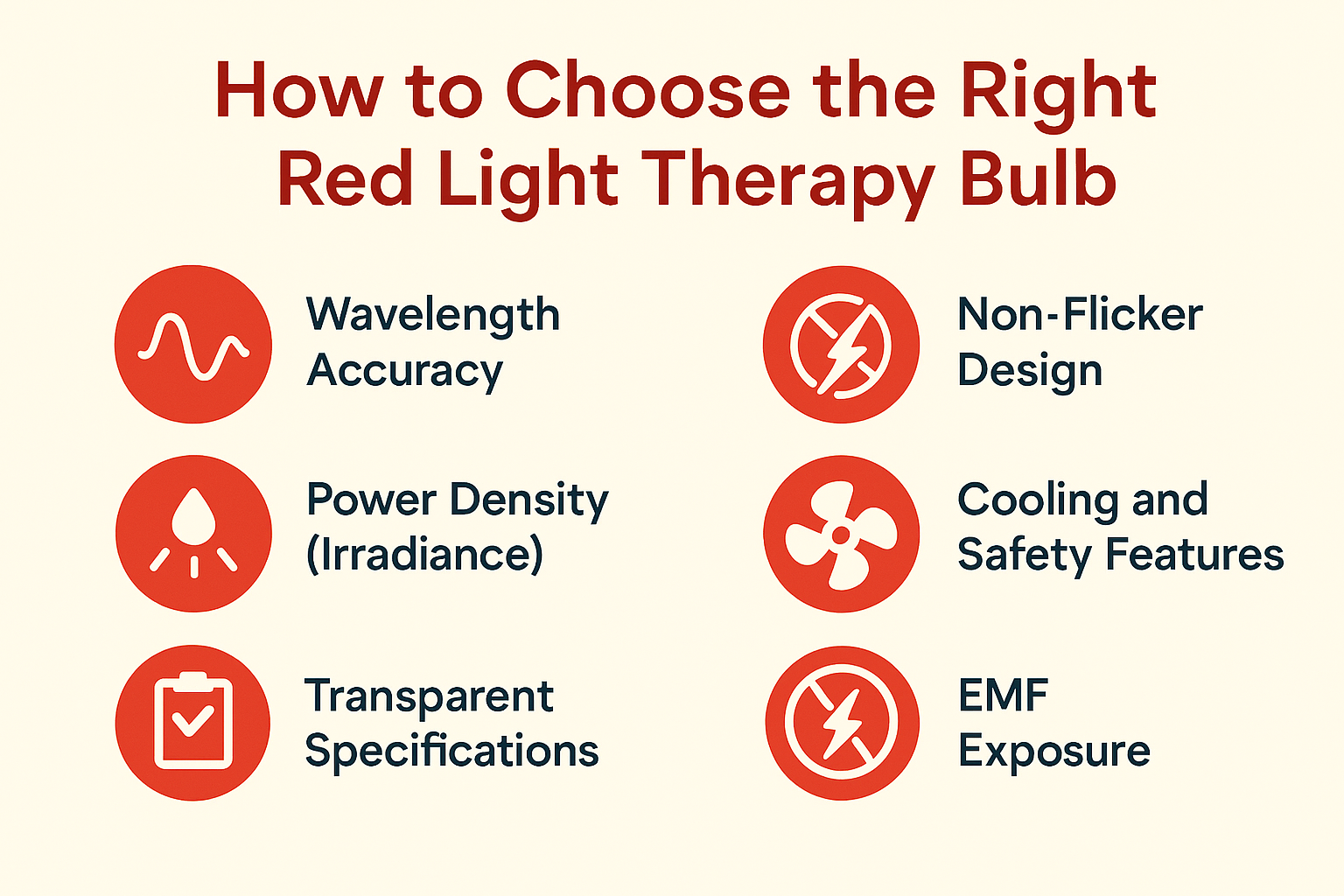
Not all red bulbs sold online are designed for therapeutic use. The difference between effective red light therapy bulbs and overpriced mood lighting often comes down to these key features:
1. Wavelength Accuracy (660nm and 850nm)
For real therapeutic benefits, look for bulbs that emit 660nm red light and/or 850nm near-infrared light. These are the wavelengths most commonly studied for skin, pain, and muscle recovery. If a product doesn’t specify this range, it’s likely not suitable for red light therapy.
2. Power Density (Irradiance)
Measured in mW/cm², this tells you how much light energy actually reaches your skin. Aim for bulbs that deliver at least 30mW/cm² at the typical treatment distance. Anything lower may require much longer sessions for potential results.
3. Non-Flicker Design
Flickering light—often invisible to the eye—can cause headaches or eye strain over time. Choose a non-flickering red light therapy bulb, especially if you plan to use it regularly.
4. Cooling and Safety Features
Most high-output red light therapy bulbs (especially those over 30W) generate noticeable heat during use. Quality bulbs are equipped with built-in cooling systems—usually heat sinks or quiet fans—to prevent overheating. This isn’t just about comfort; proper cooling protects the internal components and ensures the light maintains consistent irradiance during longer sessions.
5. EMF Exposure
While red and near-infrared light itself doesn’t emit electromagnetic fields, the electrical components in LED therapy devices (especially panels and plug-in bulbs) can produce low levels of EMFs.
Some brands design their devices to minimize EMF emissions, especially in products intended for frequent use or use near the head. If this is a concern for you, look for models marketed as low-EMF red light therapy bulbs, and check whether they list actual EMF test data.
6. Transparent, Verified Specifications
Reputable brands will list key technical details: wavelengths (e.g., 660nm, 850nm), irradiance at specific distances, and beam angle. Ideally, these numbers are backed by third-party lab testing. If a company doesn’t share specs or only provides vague claims without data, it’s usually a sign to steer clear.
Setting Up Your Red Light Therapy Bulbs at Home
Getting started with red light therapy at home is simpler than it sounds—as long as you pay attention to a few key details.
Distance matters. Most red light therapy bulbs are most effective when placed 6–12 inches from your skin. Larger devices like panels may need 12–24 inches of space. Too close, and you risk overexposure. Too far, and the light may not deliver enough energy to be useful. Take the time to measure your setup—don’t rely on guesswork.
Targeting the right areas is also important. A single bulb may work well for facial red light therapy, but for back pain, muscle recovery, or full-body use, a panel or multi-bulb setup will serve you better.
Power and safety go hand in hand. Some high-wattage devices draw significant electricity—check your outlets and avoid using extension cords with powerful bulbs. And always follow the manufacturer’s guidelines.
Eye protection is essential. While red and near-infrared light are generally safe, looking directly at bright LEDs isn’t ideal. A simple pair of light therapy goggles will protect your eyes during treatment.
Red Light Therapy Treatment Protocols and Best Practices
Red light therapy is most effective when approached with consistency, not intensity. Think of it as a long-term wellness habit—not a quick fix.
It’s recommended to follow manufacturer’s guidelines on how often to perform treatments, however many people use red light therapy in 10–20 minute sessions, two to five times per week.
Start on the shorter side and gradually increase based on your needs. For targeted red light therapy—such as sore joints or skin concerns—position the light directly over the area you’re treating.
Time of day can play a role. Morning sessions may provide a subtle energy lift, while evening treatments won’t interfere with melatonin production like blue light can. Many users find that post-workout sessions help with recovery and reduce soreness the next day.
Track your progress. A simple treatment log—note the time, distance, and area treated—can help you stay consistent and observe changes over time. Most people begin to see red light therapy results within 4–6 weeks of regular use.
Maintenance counts. Wipe down your device occasionally to remove oils or dust that could block light output. It’s a small habit that helps preserve effectiveness.
Common Red Light Therapy Issues and Troubleshooting
Even high-quality red light therapy bulbs lose effectiveness over time. If your sessions don’t seem to be working as well as they used to, check for signs of wear like visible dimming or color changes.
LED bulbs typically last between 25,000 and 50,000 hours. That’s several years of use, but daily users may notice performance decline sooner. Some devices include built-in output meters; otherwise, you may need external tools for testing.
Inconsistent results often come from inconsistent use. Changing your distance, schedule, or treatment area too often can disrupt progress. Try to stick to one routine for at least four weeks before making adjustments.
Watch for overheating. If your device feels unusually hot or you notice condensation, stop using it and contact the manufacturer. Quality devices should include automatic shut-off features to prevent overheating.
If it’s time for a red light therapy bulb replacement, consider whether an upgrade might serve you better. Newer models often offer more efficient light delivery and better long-term value.
Conclusion
Red light therapy bulbs offer a convenient way to experience the benefits of photobiomodulation at home—without the ongoing cost of spa appointments. Whether you’re targeting skin rejuvenation, pain relief, or muscle recovery, results depend on choosing the right device and using it consistently.
When it comes to equipment, quality matters more than quantity. A single, well-designed bulb with the proper wavelengths and output will outperform a larger, low-cost setup that lacks therapeutic specs. As you gain experience, you can always scale your routine based on your specific needs.
Keep in mind, results take time. Red light therapy works by supporting your body’s natural repair and regeneration processes. While timelines vary, most people begin to see noticeable improvements within 4 to 8 weeks of regular, targeted use.
Lastly, if you have any underlying medical conditions or are taking medications that cause light sensitivity, be sure to speak with your healthcare provider before beginning treatment.
Frequently Asked Questions about Red Light Therapy Bulbs
What bulb should I use for red light therapy?
Use LED bulbs specifically designed for red light therapy that emit wavelengths between 630-850nm. Medical-grade LED panels or bulbs with verified wavelength output are ideal. Avoid standard colored bulbs from hardware stores—they lack the specific wavelengths needed for photobiomodulation.
Is red light therapy the same as a red light bulb?
No, red light therapy and a red light bulb are completely different. Red light therapy bulbs emit specific wavelengths (630-660nm red, 810-850nm near-infrared) that penetrate skin and trigger cellular responses. Regular red light bulbs just produce colored light for ambiance without therapeutic wavelengths or power density.
What kind of red light do I need for red light therapy?
You need LEDs emitting red light (630-660nm) for skin benefits and near-infrared (810-850nm) for deeper tissue penetration. Look for devices with irradiance of at least 30-50 mW/cm² at treatment distance. Clinical-grade devices often combine both wavelengths for maximum effectiveness.
What wattage is best for red light therapy?
Wattage alone doesn’t determine effectiveness—irradiance (power density) matters more. Quality devices range from 20W to 300W+, but should deliver 30-100 mW/cm² at skin level. Higher wattage typically means faster treatment times and larger coverage areas.
